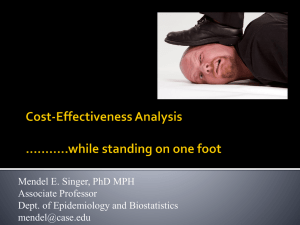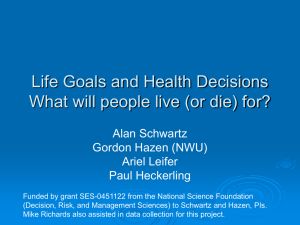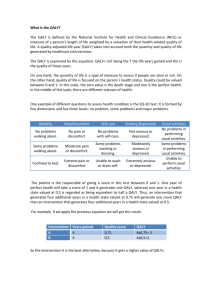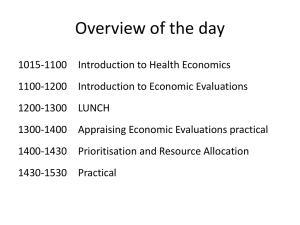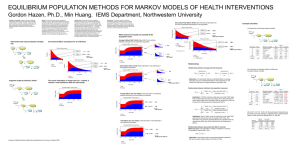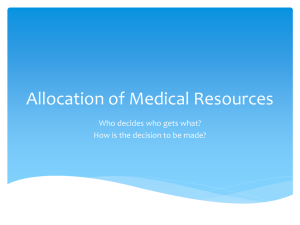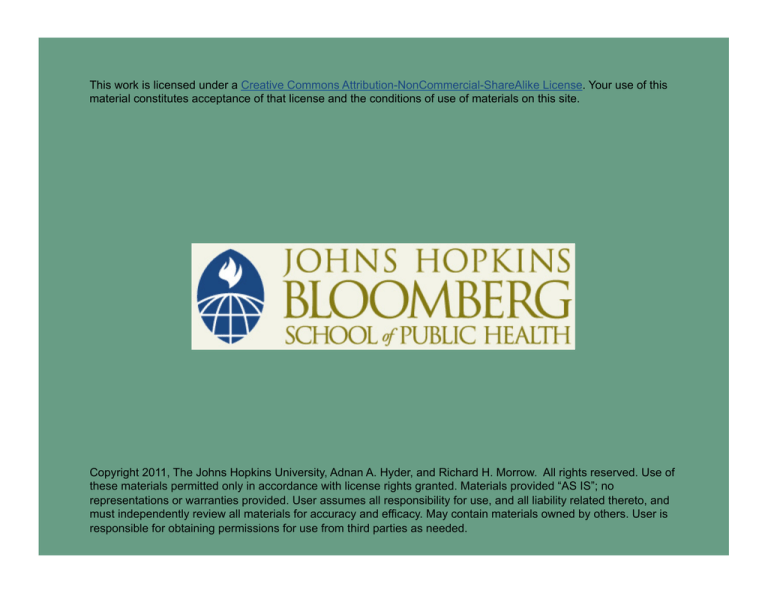
This work is licensed under a Creative Commons Attribution-NonCommercial-ShareAlike License. Your use of this
material constitutes acceptance of that license and the conditions of use of materials on this site.
Copyright 2011, The Johns Hopkins University, Adnan A. Hyder, and Richard H. Morrow. All rights reserved. Use of
these materials permitted only in accordance with license rights granted. Materials provided “AS IS”; no
representations or warranties provided. User assumes all responsibility for use, and all liability related thereto, and
must independently review all materials for accuracy and efficacy. May contain materials owned by others. User is
responsible for obtaining permissions for use from third parties as needed.
Section C: Quality Adjusted Life Years
Richard H. Morrow, MD, MPH
Quality Adjusted Life Years (QALYs)
Introduced in 1976
A measure of health status
Originally developed as a differentiating indicator for individual
choices (not to measure burden of disease in populations)
3
Comparisons of SMPH
Healthy Life Years
Disability Adjusted
Life Years
Quality Adjusted
Life Years
Health Adjusted
Life Expectancy
Ghana MOH, 1981
World Bank
Development
Report, 1993
North America,
1976
WHO Report, 2000
Purpose
Assist in resource
allocation decisions
Compare disease
burdens in many
different
populations on a
comparable basis
Assess individual
preferences for
various outcomes
from complex
interventions
Compare national
disease burdens
Level of use
National- and
district-level
decisions
Broad policy
decisions
Personal decisions
Global comparisons
Data
National and local
data from
multiple sources
Expert review
Global data and
expert opinion
Tertiary hospital
data and personal
interviews
Global data and
expert opinion
Discipline
base
Epidemiologists/
clinicians/national
planners
Economists/
statisticians
Economists/
clinicians
Demographer/
economists/
statisticians
Social values
incorporated
Future life
discounted
Age weighting
Future life
discounted
Generally not
included
Not relevant
Origin
4
QALYs
Guided by the principle of selecting among alternate health
interventions that result in different outcomes based on how an
“informed” individual will choose
An assessment of individual preferences for different health
outcomes from alternate interventions
5
Quality Adjusted Life Years (QALYs)
Central notion behind QALYs is the realization that a year spent in
one health state may be preferred over a year spent in another
health state
Comparing time spent in a health state with the value given to that
state
QALYs have been used under the assumption of maximizing utility—
based on utilitarian theories of individual choices
6
QALYs—Quality Adjusted Life Years
Definition: a single health state measure combining quantity and
quality of life
A generic measure that sums time spent in different health states
using weights on a scale of 0 (dead) to 1 (perfectly healthy) for each
health state—the arithmetic product of duration of life and a
measure of quality of the remaining life years (health state
weight)
So, five years of perfect health = 5 QALYs; two years in a state
measuresd as 0.5 of perfect health followed by three years of
perfect health = 4 QALYs
7
Quality Adjusted Life Year
Measure that combines quality and quantity of life into a single
metric
Scaled from 0 to 1
- 0 = death
- 1 = perfect health
- Many scales allow scores below zero
Graph and measure “area under the curve” (see next slide)
8
QALY Graph
9
QALYs Gained
10
Methods of Weighting (States of Illness)
11
Methods of Weighting (States of Illness)
12
Methods of Weighting (States of Illness)
13
Methods of Weighting (States of Illness)
14
Health Status Description Systems
Domain
EQ-5D
SIP
SF-35
6D5L
Mobility
Self-care
Usual
activities
Pain,
discomfort
Anxiety,
depression
Other
15
Different Health States
16
Quality Adjusted Life Years (QALYs)
The most famous application of the QALY method occurred in the
state of Oregon
The Oregon plan used the QALY approach to develop 709 conditiontreatment (CT) pairs—a fairly comprehensive set of all possible
interventions—for those receiving Medicaid
17
Oregon Health Plan: Setting Health Care Priorities
Origins of the Oregon health plan for setting health care priorities
- Political strategy for health plan: who, what covered, and how
paid
-
-
1987–1989, John Fitzhaber and Neil Goldschmidt
Principles
Universal access to care
Society responsible for financing poor
Process for defining basic level of care
Process for publicly debated criteria based on consensus of
social values and society as a whole
Health care just one factor in health and must show
balance with other programs
Funding explicit and sustainable
Accountability
18
Oregon Health Plan: Setting Health Care Priorities
Ranked health care services provided by Medicaid of all conditions
Condition—treatment pairs arranged on a cost-benefit basis using QALYs
and ranked on four factors
1. Cost
2. Estimates of effects (QALYs) of service made by panels of MDs
(more than 50)
3. Duration of benefits (QALYs)
4. Citizens views on seriousness of symptoms/functional limitations
by telephone polls and many many community hearings and
meetings
Many many problems and uproars
-
The first list ranked treatment of dental diseases higher than
appendectomy!
-
Special issues with federal Medicaid and the Americans with
Disabilities Act
-
-
Complex history over the next few years
QALYs were dropped by decisions made by citizens groups
19
Advantages of QALYs
If large studies using quality of life measuring tools/instruments are
used, e.g., EQ-5D, leads to good validity and reliability
Single measure combining quality and quantity measures
Used in cost utility analysis—which allows comparison between
interventions which nominally differ in terms of outcomes
20
Disadvantages of QALYs
Individual, not population based
Scoring based on hypothetical questions
Difficult to understand consequences when healthy
Calculation is dependent on who asked—patient, doctor, general
population
Calculation dependent on how asked, i.e., which method
21
QALY League Tables
Procedure aimed at determining priorities in health care
QALY league table ranks different interventions according to “cost
per QALY”
Essential that scope and perspective of comparisons are identical or
virtually so
As with all cost-effectiveness analyses—always comparative and
always inclusive of all possible alternatives
22
CE League Table of Recent Studies
Vaccine
Setting
$ per dose
$ per DALY averted
Hib
(Gessner et al.,
forthcoming)
Indonesia
$3.60 &
$3.00
3 doses
$47 or $62 (2006 US$)
Pediatric dengue
(Shepard et al., 2004)
SE Asia
$0.50 & $10
2 doses
$50 (2001 US$ ?)
Live attenuated JE
(Suraratdecha et al.,
2006)
Andhra Pradesh, India
$1.00
1 dose
$58 or $76 (2000 US$)
Pneumococcal
conjugate
(Sinha et al., 2007)
72 GAVI-eligible
countries
$5.00
3 doses
$100 ($57-185 95% CI)
(2000 IUS$)
Rotavirus
(Podewils et al., 2005)
Asia (low- and middleincome countries)
$5.00
2 doses
$105 & $201 (2002 US$)
Source: Damian Walker.
23
Benefits and Costs of 47 Health Interventions
24
Post Script
DALYs compared to QALYs
25
Comparison of QALYs and DALYs
DALYs = YLL (years of life lost due to death before expectation of
life had the disease not occurred) + YLD (years lived with
disability * disability weight)
QALYs = YLDs when …
1. Age weighting is not applied to YLDs and
2. Disability weights are the same and
3. Discount rates are the same
QALYs do not normally count YLL, that is, the remaining life
expected at time of death had the disease not occurred, and
normally do not discount for future life
26
QALYs Gained
27

